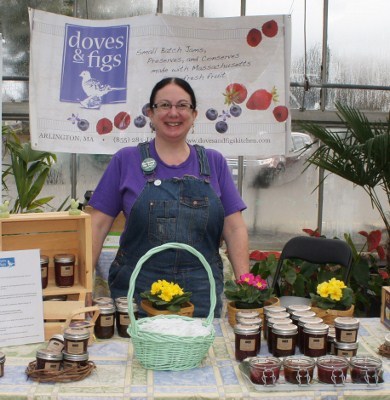Using local fruit from local farms, Robin Cohen creates preserves and jams inspired by the changing seasons of New England. An advocate of farmers markets and eating locally, I chatted with Robin about her business, Doves and Figs, the differences between jams and jellies, and asked for a few tips about getting started on canning.
I love the title of your brand, Doves and Figs. How did you come up with it, and how did you start doing this as a business?
It is inspired by a few verses in the Biblical book Song of Songs, 2:11-13, that I have loved for a long time: “The song of the doves is heard, the fig trees are fruiting and the grapes are fragrant.” Since our jams appear with the seasons, I thought it just fit so well.
I was lucky enough to try out your Rosh Hashanah “Apple, Fig, Honey Conserve.” How do you come up with your flavors?
Creating new varieties of jams and conserves is one of my favorite parts of this business. I am inspired by beautiful fruits that are in season at the same time, and by traditional holiday tastes. I search through my antique cookbooks for forgotten flavor combinations and try them out, as well as creating flavors based on something I might eat at a restaurant or a friend’s home.
Very basic question: What are the differences between jams, jellies and preserves?
Jellies are based on clear fruit juices; jams have fruit puree; preserves have pieces of the fruit as well as fruit puree; conserves (we make many of these) are bigger pieces of fruit and typically have a combination of several fruits or a mix of fresh and dried fruits or nuts. The term “preserves” is sometimes used to refer generically to all of the above.
I’m a little terrified of canning. What are a few good tips for a canning novice?
Follow the step-by-step canning directions from a good source, such as www.freshpreserving.com, or take a class. Many classes are offered by local adult education organizations and even some libraries. When I teach cooking classes, I encourage students to experiment with recipes, but when I teach canning it is just the opposite. A novice canner should pick a traditional, well-tested recipe, such as ones in the Ball Blue Book and stick to it for best results.
Has this interview whet your appetite? Find food events, blogs and recipes!

This post has been contributed by a third party. The opinions, facts and any media content are presented solely by the author, and JewishBoston assumes no responsibility for them. Want to add your voice to the conversation? Publish your own post here. MORE



